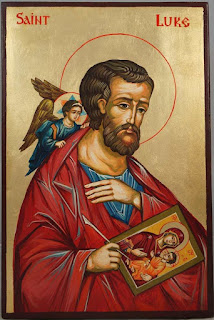Spy Wednesday (Wednesday of Holy Week): Gentlemen, there's a spy in our midst!
After
saying this Jesus was troubled in spirit, and declared, ‘Very truly, I tell
you, one of you will betray me.’ The disciples looked at one another, uncertain
of whom he was speaking. One of his disciples—the one whom Jesus loved—was
reclining next to him; Simon Peter therefore motioned to him to ask Jesus of
whom he was speaking. So while reclining next to Jesus, he asked him, ‘Lord,
who is it?’ Jesus answered, ‘It is the one to whom I give this piece of bread
when I have dipped it in the dish.’ So when he had dipped the piece of bread,
he gave it to Judas son of Simon Iscariot. After he received the piece of
bread, Satan entered into him. Jesus said to him, ‘Do quickly what you are
going to do.’ Now no one at the table knew why he said this to him. Some
thought that, because Judas had the common purse, Jesus was telling him, ‘Buy
what we need for the festival’; or, that he should give something to the poor.
So, after receiving the piece of bread, he immediately went out. And it was
night.
When
he had gone out, Jesus said, ‘Now the Son of Man has been glorified, and God
has been glorified in him. If God has been glorified in him, God will also
glorify him in himself and will glorify him at once.
John
13.21-32
Spy Wednesday : Gentlemen, there's a spy in our midst!
- Traditionally the Wednesday of Holy Week is known as 'Spy Wednesday'. The name derives not from Latin or medieval French, as Maundy does (i.e. Maundy Thursday), but from the fact that on this day Judas approaches the Jewish authorities in order to betray Jesus. On this day the Church remembers that a spy has entered into the midst of the fellowship of the disciples, one whose priorities were at odds with their, and with those of Jesus. Judas is that spy.
Judas is a
troubling and troubled character, he is presented as an unregenerate and
unredeemable monster (in particular in the Gospel of John), yet more modern
interpretations such as Jesus Christ Superstar see him as a more cautious
figure. But however well intentioned (or not) his actions, he will bring about
the crucifixion of our Lord. An action he almost immediately regrets.
Judas
is also a necessary figure. It is necessary for him to betray Jesus in order
that the sequence of events that follow may take place. That does not mean that
Judas is without agency or choice, he has the choice not to betray. (We each
know the good we should do, or are required to do, and yet still we make the
choice not to obey.) He is therefore someone we could do without, yet we cannot
do without.
The
image I have chosen looks ahead from today to late in the afternoon of Good
Friday, it is titled 'Mary comforts Judas’ mother' and is by the artist Nicholas Mynheer. Two women
comfort one another, the Blessed Virgin and the mother of Judas, and in the
background we see two men hanging from trees, one on a crucifix, the other from
a tree (Judas).
There
is a final, controversial* (and completely apocryphal) ending to this story, a moment
of redemption. On Holy Saturday, when Christ descends to the place of the dead
and Harrows Hell, he first goes to its deepest depths, and there seeks out his
friend Judas.
* Traditionally,
because what Judas had done in betraying Christ, he is viewed by the Church as
being beyond redemption. The question is whether anyon is every truly beyond the redemptive action of God.
Response: Pray or all
mothers and fathers whose children have died. Ask that they may know the
comfort of Blessed Mary, who herself knew the pain of the loss of a child.



Comments
Post a Comment